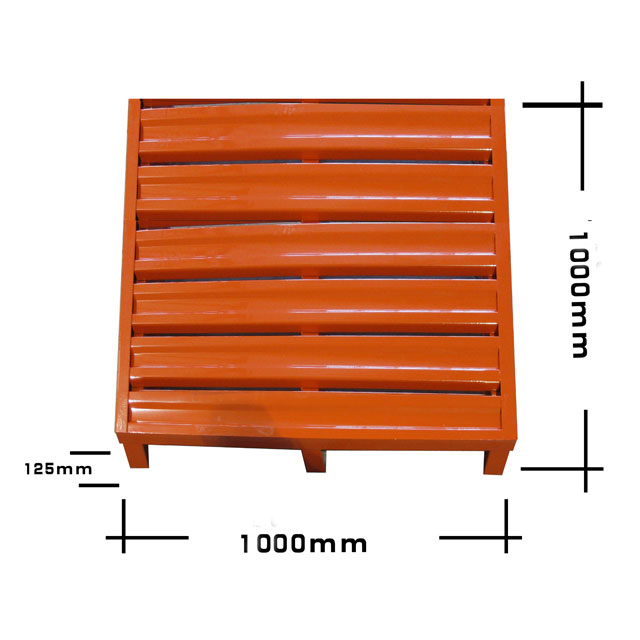
Product Description:
The International Organization for Standardization (ISO) sanctions six pallet dimensions, detailed in ISO Standard 6780: Flat pallets for intercontinental materials handling—Principal dimensions and tolerances:
|
Dimensions, mm (W × L)
|
Dimensions, in (W × L) |
Wasted floor, ISO container |
Region most used in |
|
1219 × 1016 |
48.00 × 40.00 |
11.7% (20 pallets in 40ft ISO) |
North America |
|
1000 × 1200 |
39.37 × 47.24 |
6.7% |
Europe, Asia; similar to 48x40". |
|
1165 × 1165 |
44.88 × 44.88 |
8.1% |
Australia |
|
1067 × 1067 |
42.00 × 42.00 |
11.5% |
North America, Europe, Asia |
|
1100 × 1100 |
43.30 × 43.30 |
14% |
Asia |
|
800 × 1200 |
31.50 × 47.24 |
15.2% |
Europe; fits many doorways |
North American pallets Of the top pallets used in North America, the most commonly used by far is the Grocery Manufacturers' Association (GMA) pallet, which accounts for 30% of all new wood pallets produced in the United States. The ISO also recognizes the GMA pallet footprint as one of its six standard sizes.
|
Dimensions, mm (W × L)
|
Dimensions, in (W × L) |
Production Rank |
Industries Using |
|
1219 × 1016 |
48 × 40 |
1 |
Grocery, many others |
|
1067 ×1067 |
42 × 42 |
2 |
Telecommunications, Paint |
|
1219 × 1219 |
48 × 48 |
3 |
Drums |
|
1016 × 1219 |
40 × 48 |
4 |
Military, Cement |
|
1219 × 1067 |
48 × 42 |
5 |
Chemical, Beverage |
|
1016 × 1016 |
40 × 40 |
6 |
Dairy |
|
1219 × 1143 |
48 × 45 |
7 |
Automotive |
|
1118 × 1118 |
44 × 44 |
8 |
Drums, Chemical |
|
914 × 914 |
36 × 36 |
9 |
Beverage |
|
1219 × 914 |
48 × 36 |
10 |
Beverage, Shingles, Packaged Paper |
|
889 × 1156 |
35 × 45.5 |
Unknown |
Military 1/2 ISO container, fits 36" standard doors |
|
1219 × 508 |
48 × 20 |
Unknown |
Retail |
European pallets
In Europe, the EURO pallet, also called a CEN pallet, is widely used in many industries. It measures 800 by 1200 by 144 mm. Manufacturers of EURO pallets must be sanctioned by the European Pallet Association (EPAL), which governs the smallest details, even which types of nails and lumber may be used. The strict standardization is based on the existence of Europol pallet swap organizations - their mutual swap agreements across country boundaries does only include EURO pallets of a specific EPAL/EUR type (mostly restricted to type 1). Most freight forwarders will accept pool pallets, handling the cost clearing between sender and receiver even for international transport to countries that takes part in the Europol system. The ongoing harmonization of freight handling within the European Economic Area has led to a decline of the Europol system. The EURO pallet does not fit efficiently within the ISO shipping container and slightly wider containers are often used for this reason.
The four common sizes of EURO pallets (alongside with ISO alternative sizes) are:
|
EURO pallet type
|
Dimensions, mm/in (W × L) |
ISO pallet alternative |
|
EUR, EUR 1 |
800 × 1,200 mm/31.50 × 47.24 in |
ISO1, same size as EUR |
|
EUR 2 |
1,200 × 1,000 mm/47.24 × 39.37 in |
ISO2 |
|
EUR 3 |
1,000 × 1,200 mm/39.37 × 47.24 in |
|
|
EUR 6 |
800 × 600 mm/31.50 × 23.62 in |
ISO0, half the size of EUR |
|
|
600 × 400 mm/23.62 × 15.75 in |
quarter the size of EUR |
|
|
400 × 300 mm/15.75 × 11.81 in |
one-eighth the size of EUR |
Steel pallet is an ideal replacement of traditional wooden pallet and plastic pallet. It is proper for fork man and easy accessed.
Advantages:
1, it is made of high quality steel materials, so its stable, durable and has good load capability.
2, Beautiful appearance; It has long life span and maintenance free because its surface is zinc plated and electrostatic sprayed.
3, Steel pallet is convenient for goods storing and proper for fork man.
4, it can be customized according to the load capacity and size.
5, Steel pallets are widely used in various fields like machinery, chemical, medicine, textile, foods and logistics.

